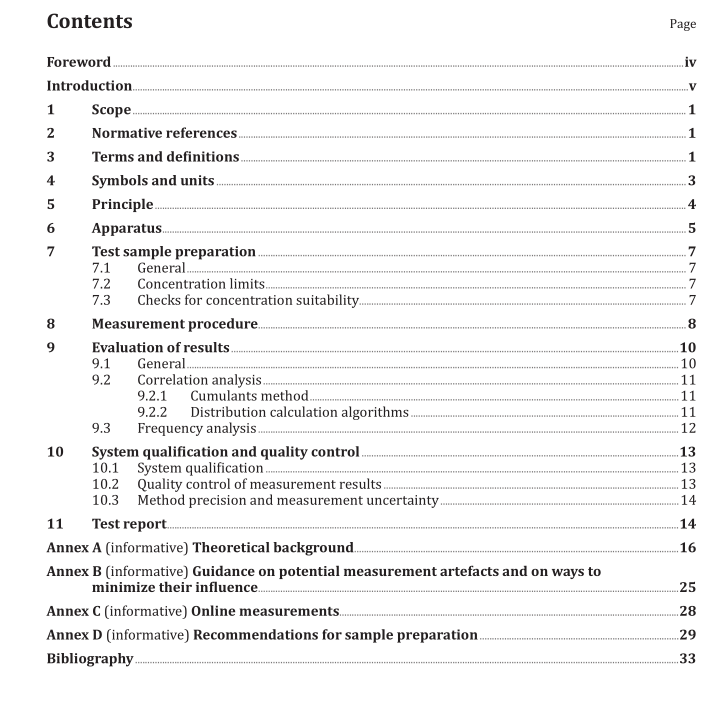BS ISO 22412:2017 pdf download.Particle size analysis — Dynamic light scattering (DLS).
This document specifies the application of dynamic light scattering (DLS) to the measurement of average hydrodynamic particle size and the measurement of the size distribution of mainly submicrometre- sized particles, emulsions or fine bubbles dispersed in liquids. DLS is also referred to as “quasi-elastic light scattering (QELS)” and “photon correlation spectroscopy (PCS),” although PCS actually is one of the measurement techniques. This document is applicable to the measurement of a broad range of dilute and concentrated suspensions.
The principle of dynamic light scattering for a concentrated suspension is the same as for a dilute suspension. However, specific requirements for the instrument setup and specification of test sample preparation are required for concentrated suspensions. At high concentrations, particle- particle interactions and multiple light scattering can become dominant and can result in apparent particle sizes that differ between concentrated and dilute suspensions.
2 Normative references
The following documents are referred to in the text in such a way that some or all of their content constitutes requirements of this document. For dated references, only the edition cited applies. For undated references, the latest edition of the referenced document (including any amendments) applies.
ISO 9276-1, Representation of results of particle size analysis — Part 1: Graphical representation
ISO 9276-2, Representation of results of particle size analysis — Part 2: Calculation of average particle sizes/diameters and moments from particle size distributions
3 Terms and definitions
For the purposes of this document, the following terms and definitions apply.
ISO and IEC maintain terminological databases for use in standardization at the following addresses:
— IEC Electropedia: available at http:// www .electropedia .org/
— ISO Online browsing platform: available at http:// www .iso .org/ obp
3.1 particle minute piece of matter with defined physical boundaries Note 1 to entry: A physical boundary can also be described as an interface.
Note 2 to entry: A particle can move as a unit. [SOURCE: ISO 26824:2013, 1.1, modified]
3.2 average hydrodynamic diameter
x DLS hydrodynamic diameter that reflects the central value of the underlying particle size distribution
Note 1 to entry: The average particle diameter is either directly determined without calculation of the particle size distribution, or calculated from the computed intensity-, volume- or number-weighted particle size distribution or from its fitted (transformed) density function. The exact nature of the average particle diameter depends on the evaluation algorithm.
Note 2 to entry: The cumulants method yields a scattered light intensity-weighted harmonic mean particle diameter, which is sometimes also referred to as the “z-average diameter.”
Note 3 to entry: Arithmetic, geometric and harmonic mean values can be calculated from the particle size distribution according to ISO 9276-2.
Note 4 to entry: Mean values calculated from density functions (linear abscissa) and transformed density functions (logarithmic abscissa) may significantly differ (ISO 9276-1).
Note 5 to entry: x DLS also depends on the particle shape and the scattering vector (and thus on the angle of observation, laser wavelength and refractive index of the suspension medium).
3.3 polydispersity index
PI dimensionless measure of the broadness of the size distribution
Note 1 to entry: The PI typically has values less than 0,07 for a monodisperse test sample of spherical particles.
3.4 scattering volume
volume defined by the intersection of the incident laser beam and the scattered light intercepted by the detector
3.5 scattered intensity
intensity of the light scattered by the particles in the scattering volume
3.6 count rate
photocurrent
Is number of photon pulses per unit time
Note 1 to entry: It is also a photodetector current which is proportional to the scattered intensity as measured by a detector.
3.7 validation
proof with reference material that a measurement procedure is acceptable for all elements of its scope
Note 1 to entry: Evaluation of trueness requires a certified reference material.
3.8 reference material
RM material, sufficiently homogeneous and stable with respect to one or more specified properties, which has been established to be fit for its intended use in a measurement process [SOURCE: ISO Guide 30:2015, 2.1.1, modified].BS ISO 22412:2017 pdf download
